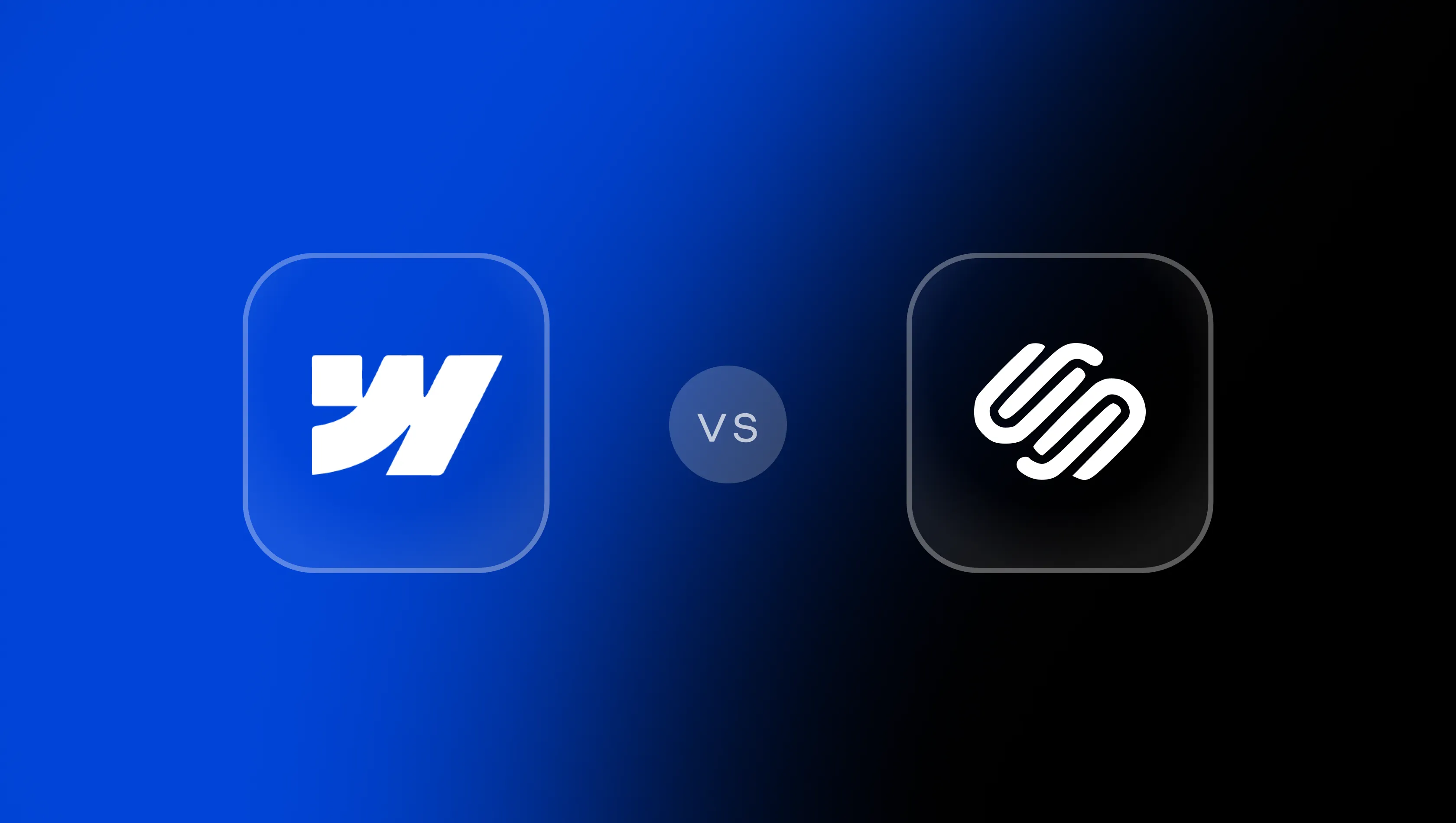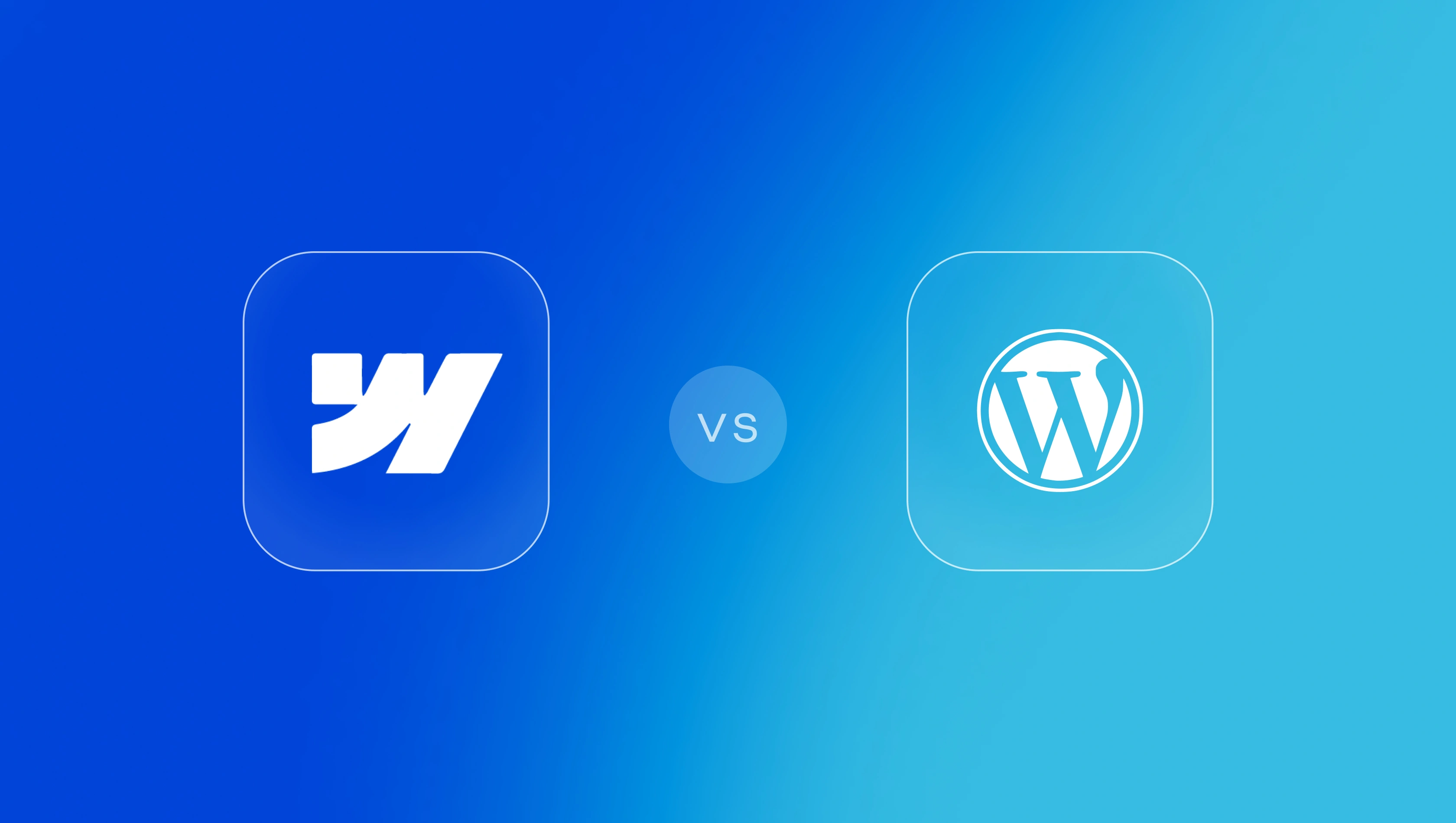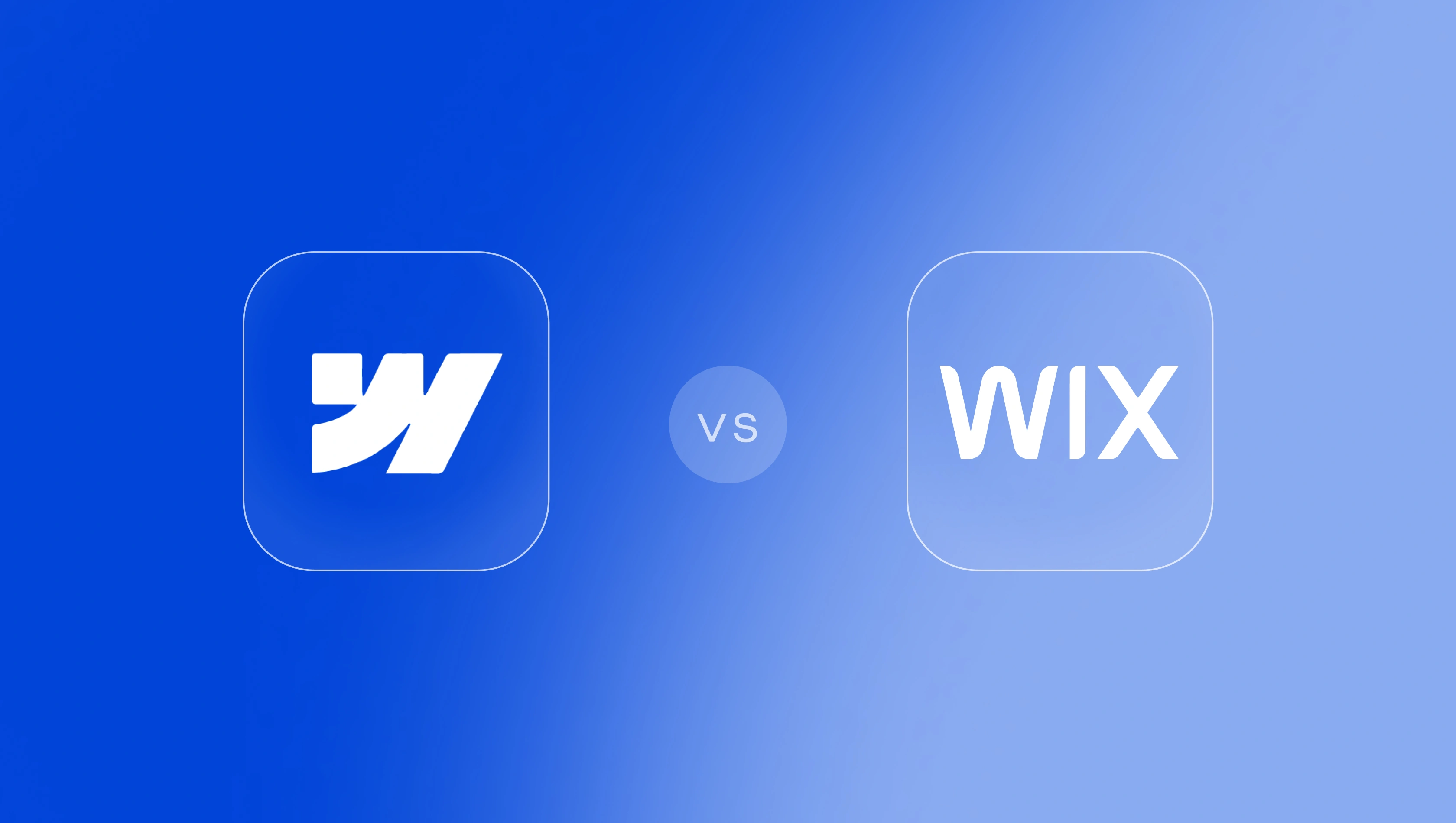Webflow vs. Squarespace: Which is Better?

Selecting the right website builder shapes how a business presents itself online. Among the most popular options, Webflow and Squarespace offer distinct approaches. Webflow prioritises creative control, advanced design freedom, and long-term optimisation, while Squarespace focuses on guided templates, ease of use, and an all-in-one setup. This comparison explores how each platform supports website design, ecommerce, and everyday functionality, helping New Zealand businesses choose the right foundation for a modern online presence.
What is Webflow?
Webflow is a professional no-code website builder that combines web design, development, and content management in one visual platform. It generates clean HTML, CSS, and JavaScript, ensuring consistent performance and scalability without external plug-ins.
The platform functions like a product design workflow for marketing sites, allowing teams to design, iterate, and publish within the same environment. Starting points such as Webflow templates or community cloneables support faster setup and align well with client-first frameworks, but most projects evolve into fully custom websites as brands grow. With flexible CMS collections, built-in SEO tools, and robust optimisation features, Webflow provides the structure and freedom needed to scale confidently.
What is Squarespace?
Squarespace is an all-in-one website builder known for its elegant templates and user-friendly setup. It combines hosting, SSL, and ecommerce features in a single platform, allowing sites to launch quickly with minimal setup.
The drag-and-drop interface and built-in SEO tools make it easy to design and maintain a professional website without technical knowledge. While Squarespace offers a guided structure that limits deep customisation, it remains a reliable choice for small businesses and content-driven sites seeking consistent design and simple upkeep.
Key Considerations
Design Flexibility
Webflow
Webflow provides advanced design flexibility through a visual interface that mirrors HTML and CSS. Designers can control layouts, spacing, fonts, and animations without coding. The platform supports responsive web design, reusable components, and detailed customisation options. Webflow offers a professional workflow that combines creative freedom with precise control, ideal for producing distinctive, high-performing websites.
Squarespace
Squarespace offers structured design flexibility through elegant templates and a drag-and-drop editor. Users can modify colours, fonts, and section layouts easily while keeping designs consistent. Its system restricts deeper custom code or structural changes, but ensures professional results with minimal effort. Squarespace offers simplicity, speed, and reliable design control suited to small businesses and visually driven websites.
Build Speed
Webflow
Webflow enables fast development once the workflow is understood. Designers can visually assemble pages while the platform generates clean HTML, CSS, and JavaScript automatically. Reusable components and global styles improve efficiency across projects. After the initial learning curve, teams can build complex, high-quality websites quickly. Webflow offers speed and flexibility ideal for scaling digital projects.
Squarespace
Squarespace focuses on fast setup and launch. Its drag-and-drop editor, built-in hosting, and curated templates allow websites to go live within hours. Users select a layout, replace content, and publish instantly without technical steps. The process favours beginners and small businesses needing rapid deployment. Squarespace offers streamlined creation suited to straightforward, template-based website building.
SEO
Webflow
Webflow gives full control over on-page SEO. Users can edit meta titles, descriptions, and markup, manage redirects, and create clean URLs. Automatic sitemaps, fast loading, and responsive structure support stronger rankings. Built-in SEO tools simplify optimisation, while custom settings allow detailed control. Webflow offers advanced flexibility for teams focused on search performance and scalable website building.
Squarespace
Squarespace covers essential SEO features within a simple interface. Users can edit titles, descriptions, and URLs while the platform generates sitemaps automatically. Its structure is efficient but less customisable than Webflow’s SEO options. Built-in SEO tools and mobile responsiveness provide solid visibility. Squarespace offers straightforward optimisation suited to small businesses and content-focused websites.
Security & Maintenance
Webflow
Webflow provides secure, managed hosting with automatic SSL, DDoS protection, and updates handled by the platform. Sites run on Amazon Web Services and Fastly for reliability and speed. No manual maintenance is required, reducing risk and downtime. Webflow offers enterprise-grade security and performance that protect data while simplifying long-term website management.
Squarespace
Squarespace delivers full security and maintenance through its all-in-one system. SSL, automatic updates, and server monitoring are included across all plans. Users avoid technical setup or plug-in management, keeping maintenance effortless. The closed platform prevents most vulnerabilities. Squarespace offers peace of mind and reliability suited to small businesses wanting a secure, maintenance-free website builder.
Ease of Use
Webflow
Webflow has a steeper learning curve but rewards teams that take the time to learn how to use Webflow effectively. Its visual editor mirrors design software while managing underlying HTML and CSS, offering precise control once mastered. The platform becomes intuitive for marketing teams familiar with layout systems and responsive behaviour. While not as beginner-friendly as Squarespace, it provides greater flexibility and professional customisation options for teams building large or evolving sites.
Squarespace
Squarespace prioritises simplicity with its beginner-friendly drag-and-drop editor and guided workflows. Users can manage content, adjust designs, and publish updates without technical knowledge. The structured templates and consistent interface make it easy to maintain design quality. This ease of use appeals to small businesses or individuals wanting a straightforward approach to website building without learning advanced design tools.
Website Hosting
Webflow
Webflow hosting runs on Amazon Web Services and Fastly CDN for global performance and reliability. Automatic SSL, caching, and uptime monitoring ensure security and speed. Users can connect a custom domain and publish instantly from the Designer. Webflow offers scalable, managed hosting that supports demanding websites without external setup or plug-ins.
Squarespace
Squarespace hosting is fully managed within its all-in-one platform. Every plan includes SSL, global delivery, and 24-hour monitoring. Users connect or purchase a custom domain directly, keeping setup simple. Performance is consistent across all plans. Squarespace offers reliable, maintenance-free hosting that suits small businesses and brands seeking fast, secure website performance.
Scalability & Future-Proofing
Webflow
Webflow scales seamlessly from small sites to complex, data-driven platforms. Its flexible CMS, custom code support, and integrations allow websites to grow without rebuilding. Clean HTML and CSS ensure long-term performance and compatibility. Webflow offers the scalability, speed, and adaptability required for brands planning continuous content or functional expansion.
Squarespace
Squarespace handles moderate growth for small businesses and online stores. Its integrated ecommerce features and blogging tools work well within a single ecosystem but limit advanced integrations. Larger or highly customised projects may outgrow the platform. Squarespace offers reliable scalability for typical business needs, while Webflow supports broader functional and design evolution.
Integrations
Webflow
Webflow supports broad integrations with CRMs, analytics, and campaign platforms. It connects easily with services like Zapier or HubSpot, allowing advanced automation and email marketing workflows. Through custom code, teams can link third-party systems while maintaining full design control. Webflow offers flexible integration for brands wanting to manage design, content, and performance in one workflow.
Squarespace
Squarespace includes built-in email marketing and social media integrations within its all-in-one environment. These tools make it simple to launch campaigns, collect leads, and monitor performance without leaving the platform. For more advanced automation, users can extend functionality through its extensions marketplace. Squarespace offers convenience and consistency for smaller teams managing content and communications in one place.
Team Collaboration & Workflows
Webflow
Webflow enables collaborative workflows for designers, developers, and content editors. Multiple users can work within shared workspaces, with defined roles and permissions. Editors update CMS content without changing layouts, maintaining brand control. Version history and structured publishing keep processes consistent. Webflow offers streamlined teamwork suited to agencies and organisations managing ongoing website updates.
Squarespace
Squarespace includes basic collaboration suited to small businesses. Users can invite contributors such as editors or store managers, each with assigned permissions. Real-time collaboration is limited, but updates remain simple and secure. Squarespace offers dependable teamwork for smaller teams maintaining ecommerce or content-driven websites without complex workflows.
Content Localisation
Webflow
Webflow includes native localisation tools that let teams translate and manage content for different regions directly within the Designer. Each locale supports custom text, images, URLs, and SEO settings. Automatic hreflang and sitemaps improve visibility across markets. Webflow offers a scalable approach to content management that simplifies multi-language website building.
Squarespace
Squarespace provides limited localisation features. Users can duplicate pages or rely on third-party translation widgets, but there is no built-in management for multi-language content. It supports global visibility through responsive templates, yet lacks detailed SEO control per region. Squarespace offers a simple solution for single-language websites, while Webflow supports advanced multilingual structures.
Customer Support
Webflow
Webflow provides support through a dedicated help centre, detailed tutorials, and active community forums. Email assistance is available, backed by extensive documentation. Webflow University offers free courses covering design tools, SEO, and ecommerce setup. Webflow offers a self-service approach with professional resources that support teams building and maintaining advanced websites.
Squarespace
Squarespace delivers responsive support through live chat, email, and a detailed knowledge base. Its tutorials and community forum help users solve common issues quickly. Guidance covers templates, SEO features, and ecommerce capabilities. Squarespace offers accessible, human-led support suited to individuals and small businesses seeking quick solutions and straightforward website management.
Pricing
Webflow
Webflow’s pricing is based on project scale and functionality. Plans range from simple static sites to complex CMS or ecommerce builds, giving flexibility to match performance and workflow needs. Each Webflow site can expand through additional workspace seats or localisation features as teams grow. Although there is no permanent free plan, users can explore the platform through a limited starter tier before upgrading. Webflow offers transparency, scalability, and control across its pricing plans.
Squarespace
Squarespace pricing is clear and all-inclusive, covering hosting, SSL, and core features such as analytics and ecommerce tools. A short free plan trial is available before selecting a paid plan, which includes email marketing and SEO tools. While it costs less than Webflow initially, it offers fewer options for scaling large or complex sites. Squarespace offers predictable, easy-to-manage pricing suited to small businesses.
Enterprise Solutions
Webflow
Webflow offers dedicated enterprise solutions for large-scale organisations. Features include enhanced security, uptime SLAs, and tailored workspace permissions. Enterprise hosting ensures performance under heavy traffic, while advanced integrations support complex systems. Webflow offers flexibility for corporate environments requiring scalability, compliance, and control across teams and regions.
Squarespace
Squarespace focuses on small to mid-sized businesses and does not provide a true enterprise plan. Its higher tiers extend functionality but remain limited in scalability and system integration. Support and hosting are consistent across plans. Squarespace offers simplicity for smaller operations, while Webflow delivers the infrastructure and adaptability expected by enterprise clients.
Webflow: Pros & Cons
Pros
Design flexibility
Webflow gives full visual control over layouts, animations, and responsive design, producing unique, high-performing websites without coding limitations.
Built-in SEO and performance
Clean HTML, CSS, and JavaScript, automatic sitemaps, and editable meta titles help improve visibility and rankings in search engines.
Scalable CMS and content structure
The content management system supports complex data relationships and dynamic content, ideal for scalable, content-rich websites.
Professional collaboration and workflows
Shared workspaces, roles, and structured publishing make collaboration efficient across design, development, and marketing teams.
Advanced integrations
Native connections and custom code support allow seamless integration with CRMs, automation, analytics, and marketing tools.
Scalable site architecture
Webflow supports modular page structures and reusable components that make site updates efficient across campaigns, ensuring consistency, faster iteration, and simpler management.
Creative control for design teams
Its visual interface mirrors real front-end code, allowing designers to maintain full brand control and design precision.
Cons
Steep learning curve
Beginners may find the interface complex, requiring time to understand Webflow’s design tools and layout structure.
Requires design knowledge
Effective use depends on understanding responsive design, the box model, and layout principles.
Higher cost for advanced plans
Webflow pricing rises with features such as localisation and advanced workspace plans, costing more than simpler website builders.
Limited plug-in ecosystem
There are fewer one-click extensions compared with WordPress or Wix, meaning some features require custom code.
Ecommerce depth
Suitable for small and medium online stores, but lacks advanced functionality found in platforms like Shopify.
Squarespace: Pros & Cons
Pros
Ease of use
Squarespace is highly intuitive, allowing quick setup through guided steps and visual drag-and-drop editing. It suits beginners and small businesses that value simplicity.
All-in-one platform
Hosting, SSL, templates, and ecommerce features are included in every plan, removing the need for external plug-ins or technical setup.
Professional templates
A wide selection of elegant, responsive Squarespace templates ensures consistent visual quality across devices with minimal effort.
Built-in SEO tools
Core SEO features such as metadata editing, mobile optimisation, and sitemaps are included, supporting visibility for smaller websites.
Reliable performance
Managed hosting and automatic updates maintain consistent uptime and security, minimising technical maintenance for users.
Integrated marketing tools
Email campaigns, social media integration, and analytics are available within the same dashboard for straightforward promotion and reporting.
Cons
Limited design flexibility
Customisation is restricted by each template’s framework, and deep edits require custom CSS or code injection.
Restricted scalability
Less suited to large or complex websites that need multi-user workflows, custom code, or advanced integrations.
Fewer integrations
The extensions marketplace offers limited options compared with platforms like Webflow, WordPress, or Shopify.
Transaction fees on lower plans
Basic ecommerce plans include additional transaction fees, increasing total costs for growing online stores.
No full localisation system
Multi-language sites require manual duplication or third-party widgets, limiting structured content management across regions.
Webflow vs Squarespace Summary
Webflow and Squarespace both deliver capable website-building solutions but meet different needs. Webflow prioritises design flexibility, scalability, and control over HTML, CSS, and SEO features, making it a strong choice for brands needing precision and growth potential. Squarespace focuses on simplicity and structure, offering refined templates, integrated hosting, and an accessible drag-and-drop setup for smaller websites.
The right choice of Squarespace vs Webflow depends on long-term goals and how much control your business needs over content, design tools, and performance. Webflow offers the flexibility to create technically advanced, visually distinctive websites that scale with your organisation.
At Edition, we design and build custom Webflow websites that combine strong creative direction with reliable performance. Each site is structured for easy content management, seamless updates, and measurable business outcomes—let’s talk.
FAQs
What makes Webflow a professional website builder?
Webflow combines visual web design with a powerful content management system, giving complete control over layouts, animations, and on-page SEO. It produces clean HTML, CSS, and JavaScript, ensuring consistent performance and responsiveness. Unlike template-based platforms, Webflow allows tailored design systems that scale easily as content or campaigns grow. For marketing teams, the platform simplifies publishing and editing, while maintaining design integrity and speed. Its combination of flexibility and technical precision makes Webflow one of the most advanced website builders available.
Is Squarespace easier to use than Webflow?
Squarespace is more accessible for beginners thanks to its drag-and-drop editor, guided structure, and built-in templates. Websites can be created quickly without any design or coding knowledge. Webflow, on the other hand, requires a learning period to understand its layouts, CSS, and design logic. Once mastered, however, it offers far greater creative freedom and scalability. Businesses that expect to grow or require precise customisation options typically benefit more from Webflow’s visual control and structured workflows than from Squarespace’s simplified setup.
Which platform performs better for SEO?
Both platforms include built-in SEO tools, but Webflow provides far deeper control. It allows direct editing of meta titles, descriptions, and markup, along with automatic sitemaps and optimised HTML structure. Pages load faster, and designers can fine-tune accessibility and mobile responsiveness. Squarespace offers good baseline visibility through automatic SEO features, but has limited control over advanced settings. For organisations relying on search performance and custom optimisation strategies, Webflow offers a more comprehensive and technically precise SEO foundation.
Can both platforms support ecommerce?
Yes, both Webflow and Squarespace include ecommerce features, though their focus differs. Squarespace offers simplicity, suitable for smaller online stores or businesses adding a few products to an existing site. Webflow provides deeper design flexibility, allowing teams to control product pages, checkout flow, and branding. While it is not as feature-rich as Shopify for large-scale retail, Webflow supports custom ecommerce capabilities that integrate well with marketing and content strategies. It’s often chosen for projects where design and storytelling matter as much as transactions.
How do pricing plans compare?
Squarespace pricing is predictable, covering hosting, SSL, and all core features in one cost. It suits small businesses wanting low-maintenance, all-in-one simplicity. Webflow’s pricing varies depending on site plans, CMS limits, and workspace collaboration tools, which provide flexibility for growing organisations. Higher tiers include localisation, additional bandwidth, and advanced features. Although Webflow may cost more at scale, its performance, structure, and control typically offset the higher pricing plans for brands seeking a tailored, professional solution.
Which is better for long-term growth?
Webflow supports long-term scalability with flexible CMS collections, advanced design tools, and the ability to extend functionality through custom code and integrations. It grows with the business, supporting larger content structures and more complex site architectures. Squarespace offers a reliable platform for straightforward website building, but its fixed structure and limited customisation can restrict future expansion. For organisations aiming to evolve their digital presence over time, Webflow provides the flexibility and technical foundation required for continuous growth.




